tow Alfa Romeo MiTo 2020 Owner handbook (in English)
[x] Cancel search | Manufacturer: ALFA ROMEO, Model Year: 2020, Model line: MiTo, Model: Alfa Romeo MiTo 2020Pages: 212, PDF Size: 5.18 MB
Page 39 of 212
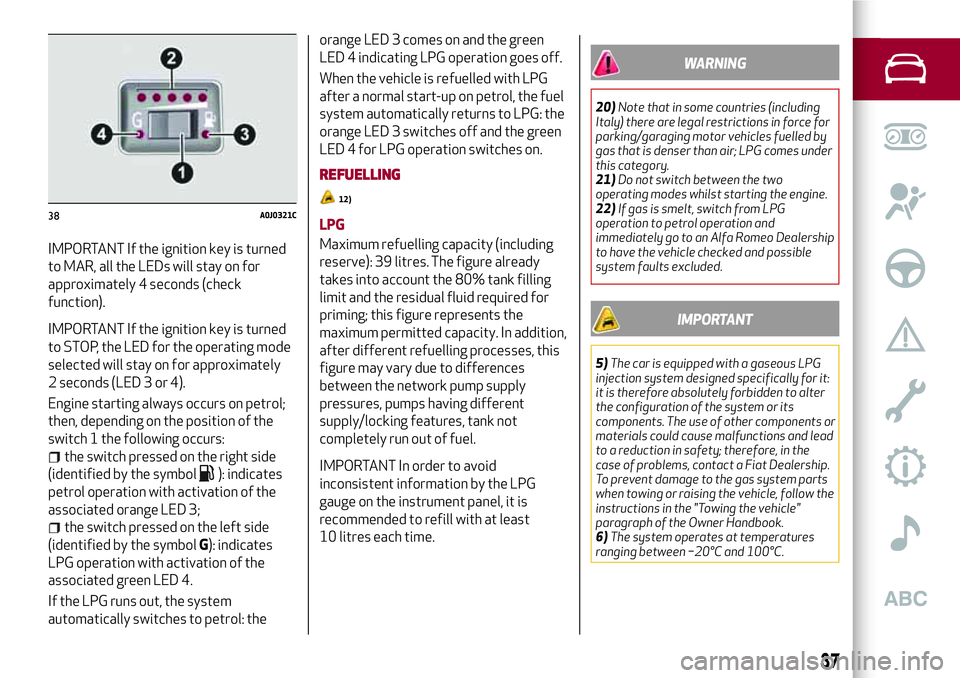
IMPORTANT If the ignition key is turned
to MAR, all the LEDs will stay on for
approximately 4 seconds (check
function).
IMPORTANT If the ignition key is turned
to STOP, the LED for the operating mode
selected will stay on for approximately
2 seconds (LED 3 or 4).
Engine starting always occurs on petrol;
then, depending on the position of the
switch 1 the following occurs:
the switch pressed on the right side
(identified by the symbol
): indicates
petrol operation with activation of the
associated orange LED 3;
the switch pressed on the left side
(identified by the symbolG): indicates
LPG operation with activation of the
associated green LED 4.
If the LPG runs out, the system
automatically switches to petrol: theorange LED 3 comes on and the green
LED 4 indicating LPG operation goes off.
When the vehicle is refuelled with LPG
after a normal start-up on petrol, the fuel
system automatically returns to LPG: the
orange LED 3 switches off and the green
LED 4 for LPG operation switches on.
REFUELLING
12)
LPG
Maximum refuelling capacity (including
reserve): 39 litres. The figure already
takes into account the 80% tank filling
limit and the residual fluid required for
priming; this figure represents the
maximum permitted capacity. In addition,
after different refuelling processes, this
figure may vary due to differences
between the network pump supply
pressures, pumps having different
supply/locking features, tank not
completely run out of fuel.
IMPORTANT In order to avoid
inconsistent information by the LPG
gauge on the instrument panel, it is
recommended to refill with at least
10 litres each time.
WARNING
20)Note that in some countries (including
Italy) there are legal restrictions in force for
parking/garaging motor vehicles fuelled by
gas that is denser than air; LPG comes under
this category.
21)Do not switch between the two
operating modes whilst starting the engine.
22)If gas is smelt, switch from LPG
operation to petrol operation and
immediately go to an Alfa Romeo Dealership
to have the vehicle checked and possible
system faults excluded.
IMPORTANT
5)The car is equipped with a gaseous LPG
injection system designed specifically for it:
it is therefore absolutely forbidden to alter
the configuration of the system or its
components. The use of other components or
materials could cause malfunctions and lead
to a reduction in safety; therefore, in the
case of problems, contact a Fiat Dealership.
To prevent damage to the gas system parts
when towing or raising the vehicle, follow the
instructions in the "Towing the vehicle"
paragraph of the Owner Handbook.
6)The system operates at temperatures
ranging between −20°C and 100°C.
38A0J0321C
37
Page 44 of 212

DISPLAY
The car is equipped with a reconfigurable
multifunction display that, according to
the previously applied settings, will show
useful driving information.
With the ignition key removed, the
display lights up and shows the time and
total odometer reading (in km or miles)
for a few seconds when a door is
opened/closed.
RECONFIGURABLE MULTIFUNCTION
DISPLAY
The following information is shown on the
display (example given in fig. 41 ):
1: Time
2: Area reserved for messages
(information, settings, etc)
3: Milometer (total distance covered
in km or miles).4: Car status indications (e.g. doors open,
possible ice on road, etc.)/Start&Stop
function indication (where
provided)/Gear Shift Indicator (where
provided)
5: Headlight alignment position (only with
dipped beam headlights on)
6: External temperature
The turbocharger pressure will appear on
some versions when “DYNAMIC” driving
mode is selected (see “Alfa DNA system”
in this chapter).
GEAR SHIFT INDICATOR
(where provided)
The GSI (Gear Shift Indicator) system
advises the driver to change gear through
a special indication on the display.
Through the GSI, the driver is informed
that the gear change will allow a
reduction in fuel consumption.
Therefore, for driving oriented towards
reducing fuel consumption, it is advisable
to stick to “Natural” or “All Weather”
mode and to follow the suggestions of
the Gear Shift Indicator, where traffic
conditions permit.
When the SHIFT UP icon
is shown on
the display the GSI suggests the driver to
up-shift, whereas if the SHIFT DOWN
icon
is displayed, the driver is advised
to down-shift.
The indication in the instrument panel
remains on until the driver shifts gear or
the driving conditions go back to a
situation where gearshifting is not
required to improve consumption.
CONTROL BUTTONS
“+” or(versions with Start&Stop
system) fig. 42: to scroll upwards through
the screen and the related options or to
increase the displayed value.
SET/
: press briefly to access the
menu and/or go to next screen or confirm
the selection. Hold down to go back to
the standard screen.
“–” or
(versions with Start&Stop
system): to scroll downwards through the
screen and the related options or to
decrease the displayed value.
IMPORTANT The control buttons
activate different functions according to
the following situations:
41A0K0600C
42A0J0302C
42
KNOWING THE INSTRUMENT PANEL
Page 52 of 212
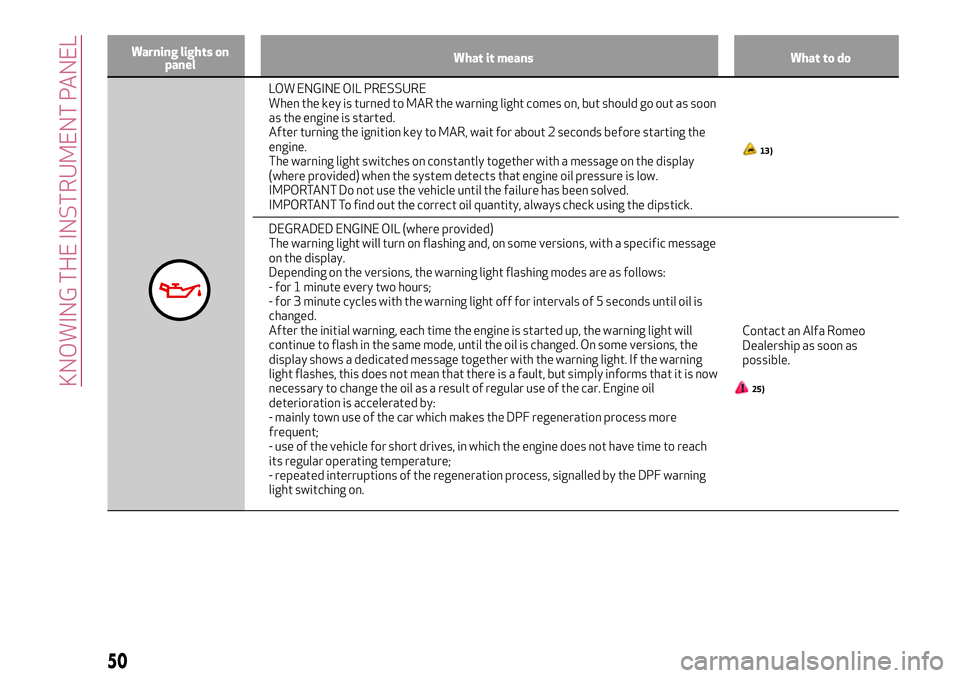
Warning lights on
panelWhat it means What to do
LOW ENGINE OIL PRESSURE
When the key is turned to MAR the warning light comes on, but should go out as soon
as the engine is started.
After turning the ignition key to MAR, wait for about 2 seconds before starting the
engine.
The warning light switches on constantly together with a message on the display
(where provided) when the system detects that engine oil pressure is low.
IMPORTANT Do not use the vehicle until the failure has been solved.
IMPORTANT To find out the correct oil quantity, always check using the dipstick.
13)
DEGRADED ENGINE OIL (where provided)
The warning light will turn on flashing and, on some versions, with a specific message
on the display.
Depending on the versions, the warning light flashing modes are as follows:
- for 1 minute every two hours;
- for 3 minute cycles with the warning light off for intervals of 5 seconds until oil is
changed.
After the initial warning, each time the engine is started up, the warning light will
continue to flash in the same mode, until the oil is changed. On some versions, the
display shows a dedicated message together with the warning light. If the warning
light flashes, this does not mean that there is a fault, but simply informs that it is now
necessary to change the oil as a result of regular use of the car. Engine oil
deterioration is accelerated by:
- mainly town use of the car which makes the DPF regeneration process more
frequent;
- use of the vehicle for short drives, in which the engine does not have time to reach
its regular operating temperature;
- repeated interruptions of the regeneration process, signalled by the DPF warning
light switching on.Contact an Alfa Romeo
Dealership as soon as
possible.
25)
50
KNOWING THE INSTRUMENT PANEL
Page 75 of 212
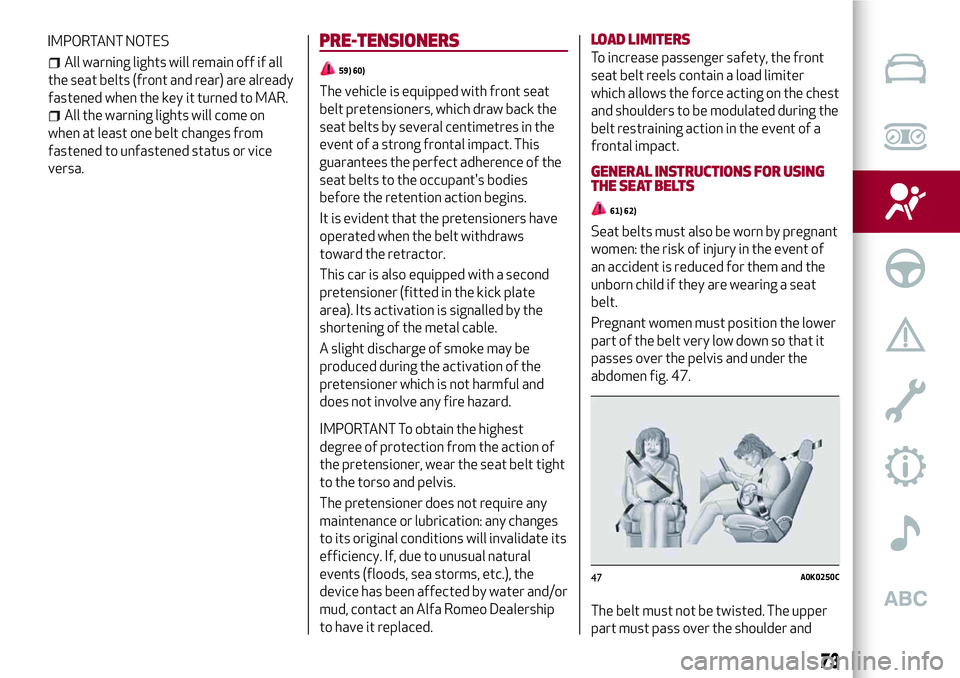
All warning lights will remain off if all
the seat belts (front and rear) are already
fastened when the key it turned to MAR.
All the warning lights will come on
when at least one belt changes from
fastened to unfastened status or vice
versa.
PRE-TENSIONERS
59) 60)
The vehicle is equipped with front seat
belt pretensioners, which draw back the
seat belts by several centimetres in the
event of a strong frontal impact. This
guarantees the perfect adherence of the
seat belts to the occupant's bodies
before the retention action begins.
It is evident that the pretensioners have
operated when the belt withdraws
toward the retractor.
This car is also equipped with a second
pretensioner (fitted in the kick plate
area). Its activation is signalled by the
shortening of the metal cable.
A slight discharge of smoke may be
produced during the activation of the
pretensioner which is not harmful and
does not involve any fire hazard.
IMPORTANT To obtain the highest
degree of protection from the action of
the pretensioner, wear the seat belt tight
to the torso and pelvis.
The pretensioner does not require any
maintenance or lubrication: any changes
to its original conditions will invalidate its
efficiency. If, due to unusual natural
events (floods, sea storms, etc.), the
device has been affected by water and/or
mud, contact an Alfa Romeo Dealership
to have it replaced.
LOAD LIMITERS
To increase passenger safety, the front
seat belt reels contain a load limiter
which allows the force acting on the chest
and shoulders to be modulated during the
belt restraining action in the event of a
frontal impact.
GENERAL INSTRUCTIONS FOR USING
THE SEAT BELTS
61) 62)
Seat belts must also be worn by pregnant
women: the risk of injury in the event of
an accident is reduced for them and the
unborn child if they are wearing a seat
belt.
Pregnant women must position the lower
part of the belt very low down so that it
passes over the pelvis and under the
abdomen fig. 47.
The belt must not be twisted. The upper
part must pass over the shoulder and
47A0K0250C
73
IMPORTANT NOTES
Page 91 of 212
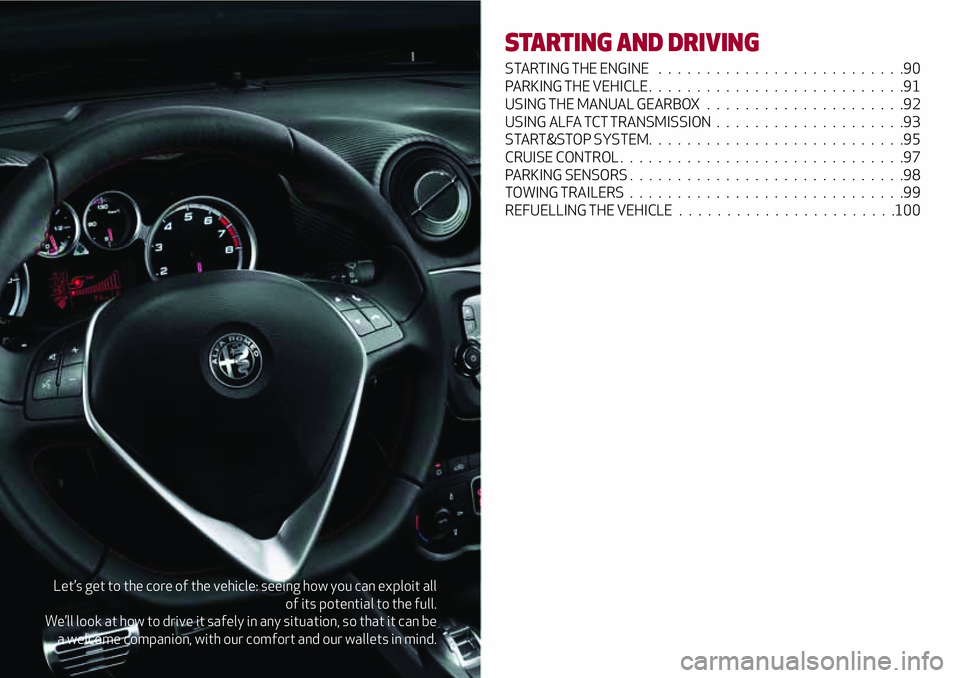
Let’s get to the core of the vehicle: seeing how you can exploit all
of its potential to the full.
We’ll look at how to drive it safely in any situation, so that it can be
a welcome companion, with our comfort and our wallets in mind.
STARTING AND DRIVING
STARTING THE ENGINE . .........................90
PARKING THE VEHICLE ...........................91
USING THE MANUAL GEARBOX .....................92
USING ALFA TCT TRANSMISSION . . . . ................93
START&STOP SYSTEM. ..........................95
CRUISE CONTROL ..............................97
PARKING SENSORS .............................98
TOWING TRAILERS . . . . . . . . .....................99
REFUELLING THE VEHICLE . . .....................100
Page 92 of 212
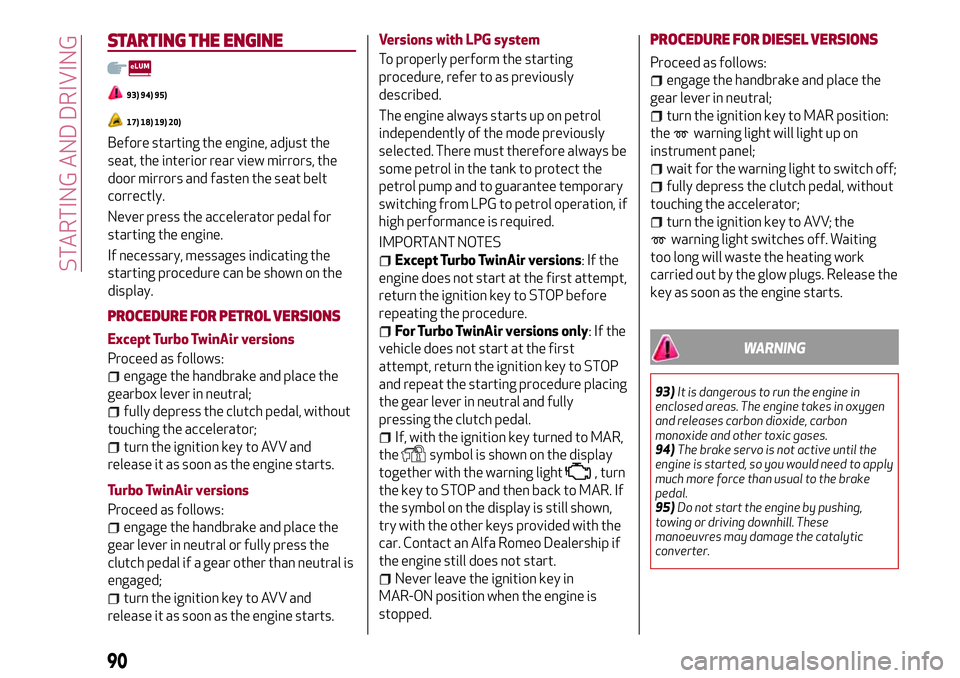
STARTING THE ENGINE
93) 94) 95)
17) 18) 19) 20)
Before starting the engine, adjust the
seat, the interior rear view mirrors, the
door mirrors and fasten the seat belt
correctly.
Never press the accelerator pedal for
starting the engine.
If necessary, messages indicating the
starting procedure can be shown on the
display.
PROCEDURE FOR PETROL VERSIONS
Except Turbo TwinAir versions
Proceed as follows:
engage the handbrake and place the
gearbox lever in neutral;
fully depress the clutch pedal, without
touching the accelerator;
turn the ignition key to AVV and
release it as soon as the engine starts.
Turbo TwinAir versions
Proceed as follows:
engage the handbrake and place the
gear lever in neutral or fully press the
clutch pedal if a gear other than neutral is
engaged;
turn the ignition key to AVV and
release it as soon as the engine starts.Versions with LPG system
To properly perform the starting
procedure, refer to as previously
described.
The engine always starts up on petrol
independently of the mode previously
selected. There must therefore always be
some petrol in the tank to protect the
petrol pump and to guarantee temporary
switching from LPG to petrol operation, if
high performance is required.
IMPORTANT NOTES
Except Turbo TwinAir versions:Ifthe
engine does not start at the first attempt,
return the ignition key to STOP before
repeating the procedure.
For Turbo TwinAir versions only:Ifthe
vehicle does not start at the first
attempt, return the ignition key to STOP
and repeat the starting procedure placing
the gear lever in neutral and fully
pressing the clutch pedal.
If, with the ignition key turned to MAR,
the
symbol is shown on the display
together with the warning light
, turn
the key to STOP and then back to MAR. If
the symbol on the display is still shown,
try with the other keys provided with the
car. Contact an Alfa Romeo Dealership if
the engine still does not start.
Never leave the ignition key in
MAR-ON position when the engine is
stopped.
PROCEDURE FOR DIESEL VERSIONS
Proceed as follows:
engage the handbrake and place the
gear lever in neutral;
turn the ignition key to MAR position:
the
warning light will light up on
instrument panel;
wait for the warning light to switch off;
fully depress the clutch pedal, without
touching the accelerator;
turn the ignition key to AVV; the
warning light switches off. Waiting
too long will waste the heating work
carried out by the glow plugs. Release the
key as soon as the engine starts.
WARNING
93)It is dangerous to run the engine in
enclosed areas. The engine takes in oxygen
and releases carbon dioxide, carbon
monoxide and other toxic gases.
94)The brake servo is not active until the
engine is started, so you would need to apply
much more force than usual to the brake
pedal.
95)Do not start the engine by pushing,
towing or driving downhill. These
manoeuvres may damage the catalytic
converter.
90
STARTING AND DRIVING
Page 95 of 212
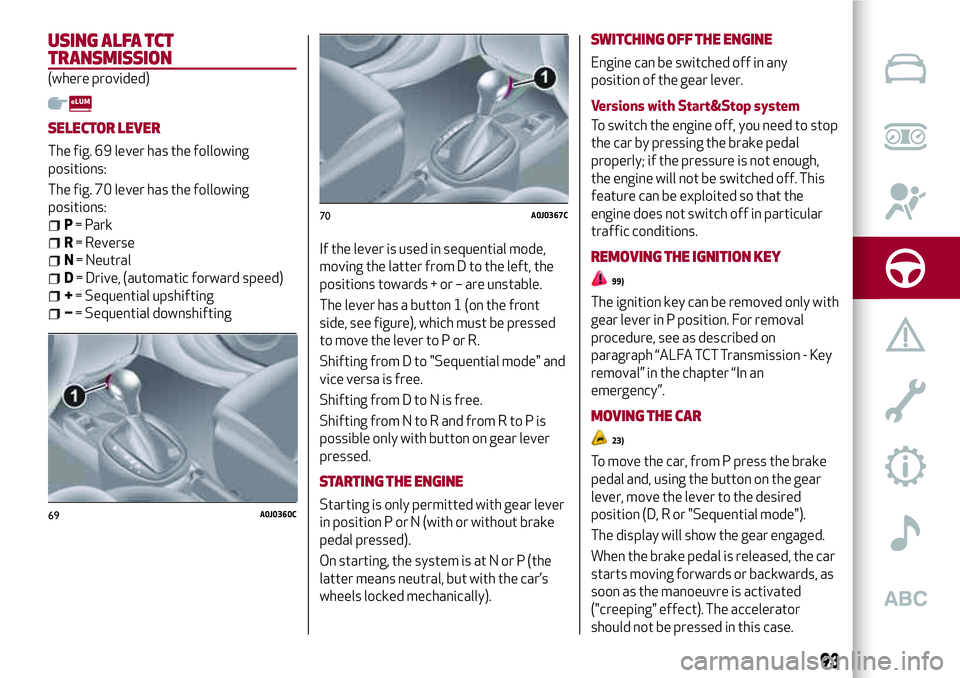
USING ALFA TCT
TRANSMISSION
(where provided)
SELECTOR LEVER
The fig. 69 lever has the following
positions:
The fig. 70 lever has the following
positions:
P= Park
R= Reverse
N= Neutral
D= Drive, (automatic forward speed)
+= Sequential upshifting
−= Sequential downshiftingIf the lever is used in sequential mode,
moving the latter from D to the left, the
positions towards + or – are unstable.
The lever has a button 1 (on the front
side, see figure), which must be pressed
to move the lever to P or R.
Shifting from D to "Sequential mode" and
vice versa is free.
Shifting from D to N is free.
Shifting from N to R and from R to P is
possible only with button on gear lever
pressed.
STARTING THE ENGINE
Starting is only permitted with gear lever
in position P or N (with or without brake
pedal pressed).
On starting, the system is at N or P (the
latter means neutral, but with the car’s
wheels locked mechanically).
SWITCHING OFF THE ENGINE
Engine can be switched off in any
position of the gear lever.
Versions with Start&Stop system
To switch the engine off, you need to stop
the car by pressing the brake pedal
properly; if the pressure is not enough,
the engine will not be switched off. This
feature can be exploited so that the
engine does not switch off in particular
traffic conditions.
REMOVING THE IGNITION KEY
99)
The ignition key can be removed only with
gear lever in P position. For removal
procedure, see as described on
paragraph “ALFA TCT Transmission - Key
removal” in the chapter “In an
emergency”.
MOVING THE CAR
23)
To move the car, from P press the brake
pedal and, using the button on the gear
lever, move the lever to the desired
position (D, R or "Sequential mode").
The display will show the gear engaged.
When the brake pedal is released, the car
starts moving forwards or backwards, as
soon as the manoeuvre is activated
("creeping" effect). The accelerator
should not be pressed in this case.
69A0J0360C
70A0J0367C
93
Page 96 of 212
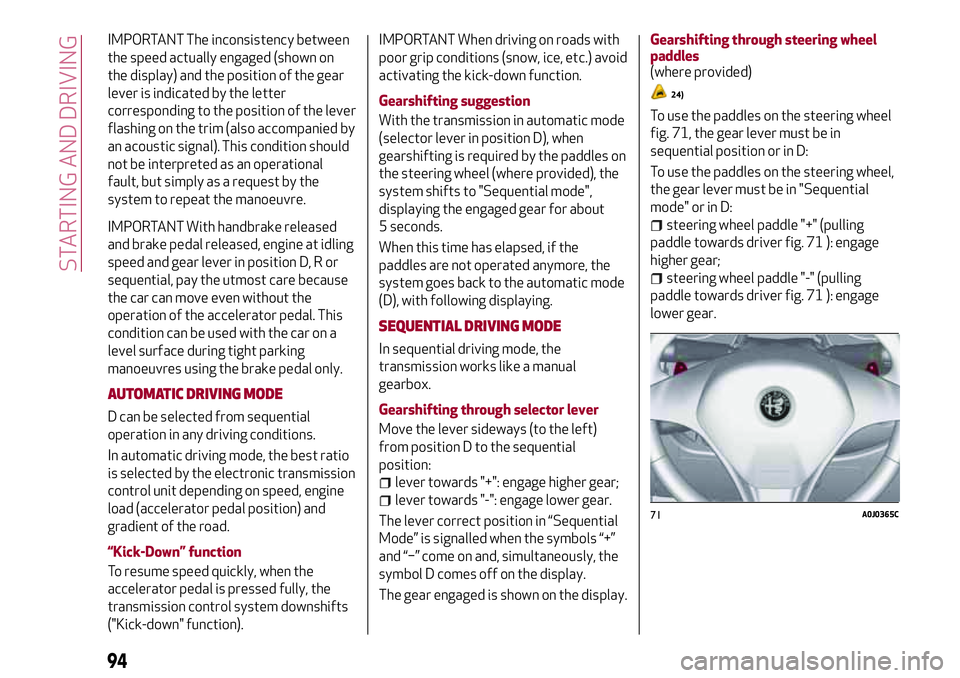
IMPORTANT The inconsistency between
the speed actually engaged (shown on
the display) and the position of the gear
lever is indicated by the letter
corresponding to the position of the lever
flashing on the trim (also accompanied by
an acoustic signal). This condition should
not be interpreted as an operational
fault, but simply as a request by the
system to repeat the manoeuvre.
IMPORTANT With handbrake released
and brake pedal released, engine at idling
speed and gear lever in position D, R or
sequential, pay the utmost care because
the car can move even without the
operation of the accelerator pedal. This
condition can be used with the car on a
level surface during tight parking
manoeuvres using the brake pedal only.
AUTOMATIC DRIVING MODE
D can be selected from sequential
operation in any driving conditions.
In automatic driving mode, the best ratio
is selected by the electronic transmission
control unit depending on speed, engine
load (accelerator pedal position) and
gradient of the road.
“Kick-Down” function
To resume speed quickly, when the
accelerator pedal is pressed fully, the
transmission control system downshifts
("Kick-down" function).
IMPORTANT When driving on roads with
poor grip conditions (snow, ice, etc.) avoid
activating the kick-down function.
Gearshifting suggestion
With the transmission in automatic mode
(selector lever in position D), when
gearshifting is required by the paddles on
the steering wheel (where provided), the
system shifts to "Sequential mode",
displaying the engaged gear for about
5 seconds.
When this time has elapsed, if the
paddles are not operated anymore, the
system goes back to the automatic mode
(D), with following displaying.
SEQUENTIAL DRIVING MODE
In sequential driving mode, the
transmission works like a manual
gearbox.
Gearshifting through selector lever
Move the lever sideways (to the left)
from position D to the sequential
position:
lever towards "+": engage higher gear;
lever towards "-": engage lower gear.
The lever correct position in “Sequential
Mode” is signalled when the symbols “+”
and “−” come on and, simultaneously, the
symbol D comes off on the display.
The gear engaged is shown on the display.Gearshifting through steering wheel
paddles
(where provided)
24)
To use the paddles on the steering wheel
fig. 71, the gear lever must be in
sequential position or in D:
To use the paddles on the steering wheel,
the gear lever must be in "Sequential
mode" or in D:
steering wheel paddle "+" (pulling
paddle towards driver fig. 71 ): engage
higher gear;
steering wheel paddle "-" (pulling
paddle towards driver fig. 71 ): engage
lower gear.
71A0J0365C
94
STARTING AND DRIVING
Page 97 of 212
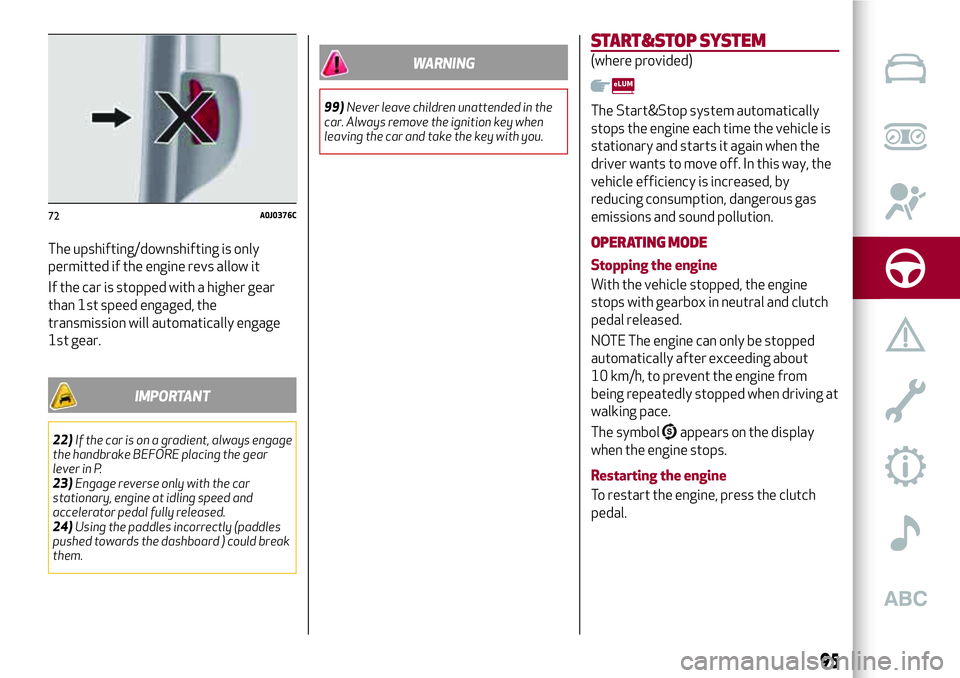
The upshifting/downshifting is only
permitted if the engine revs allow it
If the car is stopped with a higher gear
than 1st speed engaged, the
transmission will automatically engage
1st gear.
IMPORTANT
22)If the car is on a gradient, always engage
the handbrake BEFORE placing the gear
lever in P.
23)Engage reverse only with the car
stationary, engine at idling speed and
accelerator pedal fully released.
24)Using the paddles incorrectly (paddles
pushed towards the dashboard ) could break
them.
WARNING
99)Never leave children unattended in the
car. Always remove the ignition key when
leaving the car and take the key with you.
START&STOP SYSTEM
(where provided)
The Start&Stop system automatically
stops the engine each time the vehicle is
stationary and starts it again when the
driver wants to move off. In this way, the
vehicle efficiency is increased, by
reducing consumption, dangerous gas
emissions and sound pollution.
OPERATING MODE
Stopping the engine
With the vehicle stopped, the engine
stops with gearbox in neutral and clutch
pedal released.
NOTE The engine can only be stopped
automatically after exceeding about
10 km/h, to prevent the engine from
being repeatedly stopped when driving at
walking pace.
The symbol
appears on the display
when the engine stops.
Restarting the engine
To restart the engine, press the clutch
pedal.
72A0J0376C
95
Page 99 of 212

CRUISE CONTROL
(where provided)
DESCRIPTION
This is an electronic driving aid that
allows you to drive at a speed of above
30 km/h on long and straight dry roads
(e.g. motorways), at a preset speed
without having to press the accelerator
pedal. It is therefore not recommended
to use this device on extra-urban roads
with traffic. Do not use it in town.
ACTIVATING THE DEVICE
101) 102)
Turn ring 1 fig. 74 to ON.
The device cannot be engaged in 1stor
reverse gear: it is advisable to engage it
in 5
thgear or higher.When travelling downhill with the device
engaged, the car may slightly exceed the
stored speed.
Activation is indicated by the
warning
light switching on and, on some versions,
by a message on the display.
SETTING THE DESIRED SPEED
Proceed as follows:
turn ring 1 fig. 74 to ON and press the
accelerator to reach the required speed;
move the stalk upwards (+) for at least
1 second, then release it: the car speed is
now stored and you can therefore release
the accelerator.
If needed (when overtaking for instance),
you can accelerate simply by pressing the
accelerator; when you release the pedal,
the vehicle goes back to the speed stored
previously.
RESTORING THE MEMORISED SPEED
If the device has been disengaged by
pressing the brake or clutch pedal, the
stored speed can be reset as follows:
accelerate gradually until a speed
approaching the one stored is reached;
engage the gear selected at the time
that the speed was stored;
press the RES 2 fig. 74 button.
INCREASING THE MEMORISED SPEED
Press the accelerator and store the new
speed or move the stalk upwards (+).
REDUCING THE MEMORISED SPEED
Deactivate the device and store the new
speed or move the lever upwards (–) until
the new speed is reached. It will then
automatically be memorised.
DEACTIVATING THE DEVICE
To turn the device off:
Turn the ring 1 fig. 74 to the OFF
position;
or
switch off the engine;
or
press the brake pedal, the clutch or the
accelerator; in this last case the system is
not effectively deactivated but the
system gives priority to the acceleration
request. The device still remains active,
without the need to press the RES button
to return to the previous conditions once
acceleration is concluded.
Automatic deactivation
The device is automatically switched off
in the following cases:
if the ABS or ESC systems intervene;
with the vehicle speed below the set
limit;
in the event of system failure.
74A0J0065C
97